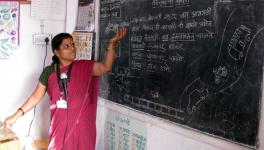Parliamentary Panel Finds over 40% Govt Schools Across India Don’t Have Electricity and Playgrounds

Image Courtesy: The Hindu
Identifying the shortfalls in budgetary funding and utilisation, a parliamentary panel on education has found that close to half of government schools across the country don’t have access to electricity or proper playgrounds.
The Parliamentary Standing Committee on Human Resource Development (HRD), in its report—Demands for Grants 2020-21 Analysis—which was submitted to Rajya Sabha last week, said that budgetary allocations saw a 27% cut from proposals made by the School Education department. Though the proposal for Rs 82,570 crore had been made, only Rs 59,845 crore were allocated.
Citing the latest survey data, the panel expressed dismay over the critical infrastructure gaps in government schools. According to the Unified District Information System for Education (UDISE) 2017-18 survey, only 56% of schools have access to electricity, with the lowest rates in Manipur and Madhya Pradesh, where less than 20% schools have access to power. In Odisha and Jammu and Kashmir, less than 30% schools have playgrounds. In total, only about 57% of schools have playgrounds across the country. However, about 40% of schools do not have a boundary wall which could ensure safety of the students and school property.
The panel recommended that the HRD Ministry collaborate with the Mahatma Gandhi National Rural Employment Guarantee Scheme (MGNREGS) to construct boundary walls, and work with the Ministry of New and Renewable Energy to provide solar energy and other renewable energy sources to ensure power access to all the schools.
It is not just about electricity, playground and boundary walls, but the government schools lack infrastructure—classrooms, library, labs, etc. The parliamentary panel also lamented the government for its “dismal” rate of progress in building classrooms, labs and libraries to strengthen government’s higher secondary schools. Of the total 2,613 sanctioned projects for 2019-20, only three had been completed during the first nine months of the financial year, found the panel, warning that such delays would alienate students from the government schools.
Though 1,021 additional classrooms had been sanctioned for the financial year of 2019-20, not a single one was built during this period.
However, the data for secondary schools shows a different picture. In secondary schools, 70-75% of such facilities had been made available by December. In case of primary schools, infrastructure completion rate was at a record of 90-95%.
For the Samagra Shiksha Scheme, the department had only spent 71% of revised estimates by December 31, 2019. “The committee would like to impress upon the department to look into the factors impeding the infrastructure development and resolve them at the earliest so as to ensure that the students get the best possible facilities,” said the report.
“The committee is aware of the fact that delay in completion of infrastructure not only leads to students getting alienated from the government schools, but also leads to cost overruns and cause an additional strain on the financial resources of the country,” the report added.
School dropouts
One of the main issues that the schools face is the number of student dropouts. There are many socio-economic reasons behind such dropouts. According to the report, the dropout rate peaks at the secondary level (class 9-10) at 17% as compared to 4% in elementary school (class 1-8) and 2% in upper secondary school (class 11-12).
Some of the key reasons for females dropping out include: to engage in domestic activities (30%), lack of interest in education (15%), and marriage (13%). On the other hand, the key reasons for males dropping out are: engage in economic activities (37%), financial constraints (24%), and lack of interest in education (19%), according to NSSO data (2018).
Get the latest reports & analysis with people's perspective on Protests, movements & deep analytical videos, discussions of the current affairs in your Telegram app. Subscribe to NewsClick's Telegram channel & get Real-Time updates on stories, as they get published on our website.
























